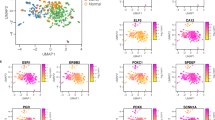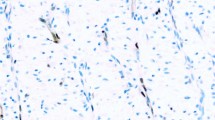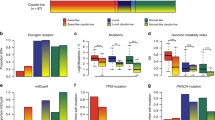Abstract
The elucidation of molecular alterations that occur during human breast cancer progression may contribute to the development of preventative strategies. Using in situ hybridizations on a cohort of 94 biopsy lesions, quantitatively increased cyclin D mRNA expression levels were observed in only 18% of benign lesions, which confer no or slightly increased breast cancer risk, and 18% of premalignant atypical ductal hyperplasias, which confer a four to fivefold increase in breast cancer risk. The transition to carcinoma was accompanied by frequent cyclin D mRNA overexpression in 76% of low-grade ductal carcinomas in situ, 87% of higher grade comedo ductal carcinomas in situ and 83% of infiltrating ductal breast carcinomas. The data identify a molecular event that may separate benign and premalignant human breast lesions from any form of breast carcinoma.
This is a preview of subscription content, access via your institution
Access options
Subscribe to this journal
Receive 12 print issues and online access
$209.00 per year
only $17.42 per issue
Buy this article
- Purchase on Springer Link
- Instant access to full article PDF
Prices may be subject to local taxes which are calculated during checkout
Similar content being viewed by others
References
Page, D. & DuPont, W. Anatomic indicators (histologic and cytologic) of increased breast cancer risk. Breast Cancer Res. Treat. 28, 157–166 (1993).
Page, D. & DuPont, W. Anatomic markers of human premalignancy and risk of breast cancer. Cancer 66, 1326–1335 (1990).
DuPont, W. & Page, D. Risk factors for breast cancer in women with proliferative breast disease. New Engl. J. Med. 312, 146–151 (1985).
Buckley, M. et al. Expression and amplification of cyclin genes in human breast cancer. Oncogens 8, 2127–2133 (1993).
Keyomarsi, K. & Pardee, A. Redundant cyclin overexpression and gene amplification in breast cancer cells. Proc. natn. Acad. Sci. U.S.A. 90, 1112–1116 (1993).
Crissman, J., Visscher, W. & Kubus, J. Image cytophotometric DNA analysis of atypical hyperplasias and intraductal carcinomas of the breast. Arch. Path. lab. Med. 114, 1249–1253 (1990).
Carpenter, R., Gibbs, N., Matthews, T. & Cooke, T. Importance of cellular DNA content in pre-malignant breast disease and pre-invasive carcinoma of the female breast. Br. J. Surg. 74, 905–906 (1987).
Ohuchi, N. et al. Expression of tumor-associated antigen (DF3) in atypical hyperplasias and in situ carcinomas of the human breast. J. natn. Cancer Inst 79, 109–117 (1987).
Lodato, R., Maguire, H., Greene, M., Weiner, D. & LiVolsi, V. Immunohistochemical evaluation of c-erb-B-2 oncogene expression in ductal carcinoma in situ and atypical ductal hyperplasia of the breast. Modern Path. 3, 449–454 (1990).
Umekita, Y., Takasaki, T. & Yoshida, H. Expression of p53 protein in benign epithelial hyperplasia, atypical ductal hyperplasia, non-invasive and invasive mammary carcinoma: An immunohistochemical study. Virchows Archiv. 424, 491–494 (1994).
Tsuda, H., Iwaya, K., Fukutomi, T. & Hirohashi, S. p53 mutations and c-erb-B-2 amplification in intraductal and invasive breast carcinomas of high histological grade. Jpn. J. Cancer Res. 84, 394–401 (1993).
Poller, D., Roberts, E., Bell, J., Elston, C., Blamey, R. & Ellis, I. p53 protein expression in mammary ductal carcinoma in situ: Relationship to immunohistochemical expression of estrogen receptor and c-erb-B-2 protein. Hum. Path. 24, 463–468 (1993).
O'Malley, F. et al. D.p53 mutations are confined to the comdeo type ductal carcinoma in situ of the breast. Immunohistochemical and sequencing data. Lab. Invest. 71, 67–72 (1994).
Giri, D., Dundas, S., Nottingham, J. & Underwood, J. Oestrogen receptors in benign epithelial lesions and intraduct carcinomas of the breast: An immunohistological study. Histopathology 15, 575–584 (1989).
Bur, M., Zimarowski, M., Schnitt, S., Baker, S. & Lew, R. Estrogen receptor immunohistochemistry in carcinoma in situ of the breast. Cancer 69, 1174–1181 (1992).
O'Connell, P., Pekkel, V., Fuqua, S., Osborne, C. & Allred, C. Molecular genetic studies of early breast cancer evolution. Breast Cancer Res. Treat. 32, 5–12 (1994).
Zhang, S.-Y., Camano, J., Cooper, F., Guo, X. & Klein-Szanto, A. Immunohistochemistry of cyclin D1 in human breast cancer. Am. J. clin. Path. 102, 695–698 (1994).
Gillett, C. et al. Amplification and overexpression of cyclin D1 in breast cancer detected by immunohistochemical staining. Cancer Res. 54, 1812–1817 (1994).
Bartkova, J. et al. Cyclin D1 protein expression and function in human breast cancer. Int. J. Cancer 57, 353–361 (1994).
Wang, T. et al. Mammary hyperplasia and carcinoma in MMTV-cyclin D1 transgenic mice. Nature 369, 669–671 (1994).
Sicinski, P. et al. Cyclin D1 provides a link between development and oncogenesis in the retina and breast. Cell 82, 621–630 (1995).
Han, E.K.-H. et al. Stable overexpression of cyclin D1 in a human mammary epithelial cell line prolongs the S-phase and inhibits growth. Oncogene 10, 953–961 (1995).
Musgrove, E., Lee, C., Buckley, M. & Sutherland, R. Cyclin D1 induction in breast cancer cells shortens G1 and is sufficient for cells arrested in G1 to complete the cell cycle. Proc. natn. Acad. Sci. U.S.A. 91, 8022–8026 (1994).
Xiong, Y., Connolly, T., Futcher, B. & Beach, D. D-type cyclin. Cell 65, 691–699 (1991).
Pines, J. & Hunter, T. Human cyclin A is adenovirus E1A-associated protein p60 and behaves differently from cyclin B. Nature 346, 760–763 (1990).
Lukas, J., Pagano, M., Staskova, Z., Draetta, G. & Bartek, J. Cyclin D1 protein oscillates and is essential for cell cycle progression in human tumour cell lines. Oncogene 9, 707–718 (1994).
Author information
Authors and Affiliations
Rights and permissions
About this article
Cite this article
Weinstat-Saslow, D., Merino, M., Manrow, R. et al. Overexpression of cyclin D mRNA distinguishes invasive and in situ breast carcinomas from non-malignant lesions. Nat Med 1, 1257–1260 (1995). https://doi.org/10.1038/nm1295-1257
Received:
Accepted:
Issue Date:
DOI: https://doi.org/10.1038/nm1295-1257
This article is cited by
-
Novel B, C-ring truncated deguelin derivatives reveals as potential inhibitors of cyclin D1 and cyclin E using molecular docking and molecular dynamic simulation
Molecular Diversity (2022)
-
A “turn-on” DNA-scaffolded silver-nanocluster probe for detection of tumor-related mRNA
Analytical Sciences (2022)
-
Molecular profile of atypical hyperplasia of the breast
Breast Cancer Research and Treatment (2018)
-
C-X-C motif chemokine 12/C-X-C chemokine receptor type 7 signaling regulates breast cancer growth and metastasis by modulating the tumor microenvironment
Breast Cancer Research (2014)
-
CFIm25 links alternative polyadenylation to glioblastoma tumour suppression
Nature (2014)



